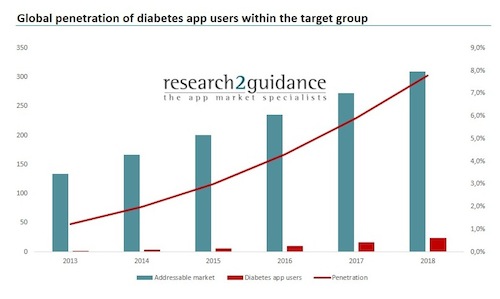 Only about 1.2 percent of people with diabetes who own a smartphone use a mobile application to manage their condition, according to a new report by Research2Guidance. That's a group of about 1.6 million users. However, the firm predicts that by 2018 that number will rise to 24 million users, or 7.8 percent of smartphone owners with diabetes. Correction: The original version of this lead said 1.2 percent of all people with diabetes used apps, not 1.2 percent of smartphone owners with diabetes.
Only about 1.2 percent of people with diabetes who own a smartphone use a mobile application to manage their condition, according to a new report by Research2Guidance. That's a group of about 1.6 million users. However, the firm predicts that by 2018 that number will rise to 24 million users, or 7.8 percent of smartphone owners with diabetes. Correction: The original version of this lead said 1.2 percent of all people with diabetes used apps, not 1.2 percent of smartphone owners with diabetes.
Research2Guidance is using numbers from the IDF Diabetes Atlas to calculate those percentages. It puts the number of people around the world with diabetes at 382 million, expected to hit 592 million by 2035. Research2Guidance rates diabetes as the therapeutic area with the most business potential for mobile health apps.
In a blog post about the study, research director Ralf-Gordon Jahns wrote about why the market penetration is currently low.
"The main reason is that the majority of today’s 1,100 diabetes apps do not meet best practice standards," he wrote. "Apps still rely to a great extent on manual input of e.g. test results. Interoperability with existing glucose meters and health and fitness apps to import blood sugar test, activity and food intake data is only an exception. Only a few diabetes apps take care of the important motivational aspect of diabetes management by using gamification elements, a supporting design as well as communication features to get feedback from friends and the physician."
Jahns also identifies four factors that will drive up the adoption of mobile health apps. One is the increase in incidence of diabetes itself. Another is a change in the conception of mobile apps, from standalone software products to bundles that use the app to sell devices, such as glucometers and wearable sensors, or services, such as remote monitoring and consultation.
He also cites the increased availability of apps for diabetes management in general, and in particular, apps that adopt best practices. Finally, reimbursement of diabetes apps by traditional payors will help spur adoption. WellDoc's BlueStar system is a good example of a reimbursable diabetes app, as well as an app that's sold in a bundle with services.














